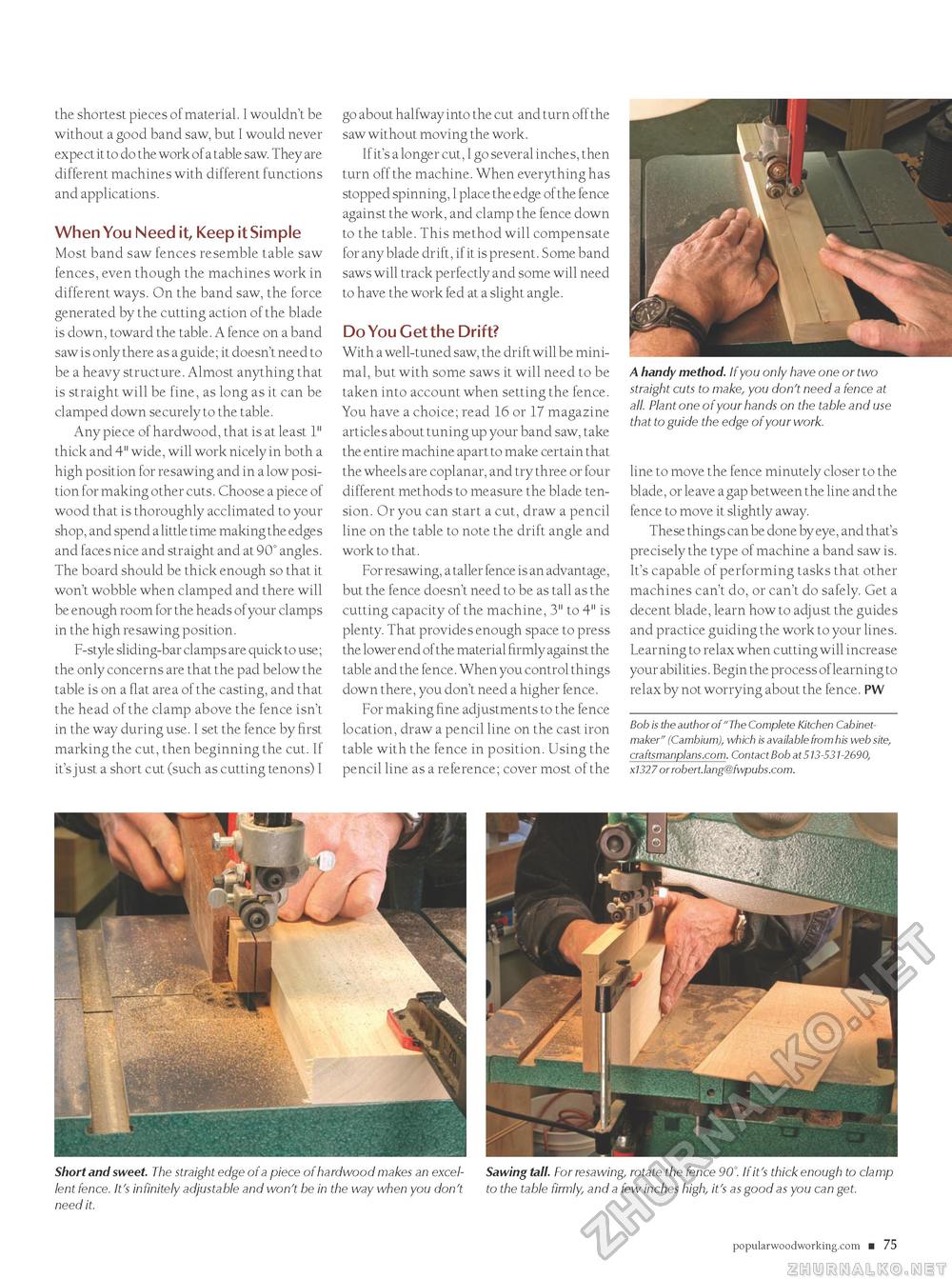Popular Woodworking 2008-04 № 168, страница 85
the shortest pieces of material. I wouldn't be without a good band saw, but I would never expect it to do the work of a table saw. They are different machines with different functions and applications. When You Need it, Keep it Simple Most band saw fences resemble table saw fences, even though the machines work in different ways. On the band saw, the force generated by the cutting action of the blade is down, toward the table. A fence on a band saw is only there as a guide; it doesn't need to be a heavy structure. Almost anything that is straight will be fine, as long as it can be clamped down securely to the table. Any piece of hardwood, that is at least 1"" thick and 4" wide, will work nicely in both a high position for resawing and in a low position for making other cuts. Choose a piece of wood that is thoroughly acclimated to your shop, and spend a little time making the edges and faces nice and straight and at 90° angles. The board should be thick enough so that it won't wobble when clamped and there will be enough room for the heads of your clamps in the high resawing position. F-style sliding-bar clamps are quick to use; the only concerns are that the pad below the table is on a flat area of the casting, and that the head of the clamp above the fence isn't in the way during use. I set the fence by first marking the cut, then beginning the cut. If it's just a short cut (such as cutting tenons) I go about halfway into the cut and turn off the saw without moving the work. If it's a longer cut, I go several inches, then turn off the machine. When everything has stopped spinning, I place the edge of the fence against the work, and clamp the fence down to the table. This method will compensate for any blade drift, if it is present. Some band saws will track perfectly and some will need to have the work fed at a slight angle. Do You Get the Drift? With a well-tuned saw, the drift will be minimal, but with some saws it will need to be taken into account when setting the fence. You have a choice; read 16 or 17 magazine articles about tuning up your band saw, take the entire machine apart to make certain that the wheels are coplanar, and try three or four different methods to measure the blade tension. Or you can start a cut, draw a pencil line on the table to note the drift angle and work to that. For resawing, a taller fence is an advantage, but the fence doesn't need to be as tall as the cutting capacity of the machine, 3" to 4" is plenty. That provides enough space to press the lower end of the material firmly against the table and the fence. When you control things down there, you don't need a higher fence. For making fine adjustments to the fence location, draw a pencil line on the cast iron table with the fence in position. Using the pencil line as a reference; cover most of the A handy method. If you only have one or two straight cuts to make, you don't need a fence at all. Plant one of your hands on the table and use that to guide the edge of your work. line to move the fence minutely closer to the blade, or leave a gap between the line and the fence to move it slightly away. These things can be done by eye, and that's precisely the type of machine a band saw is. It's capable of performing tasks that other machines can't do, or can't do safely. Get a decent blade, learn how to adjust the guides and practice guiding the work to your lines. Learning to relax when cutting will increase your abilities. Begin the process of learning to relax by not worrying about the fence. PW Bob is the author of "The Complete Kitchen Cabinetmaker" (Cambium), which is available from his web site, craftsmanplans.com. Contact Bob at 513-531-2690, x1327 or robert.lang@fwpubs.com. Short and sweet. The straight edge of a piece of hardwood makes an excel- Sawing tall. For resawing, rotate the fence 90°. If it's thick enough to clamp lent fence. It's infinitely adjustable and won't be in the way when you don't to the table firmly, and a few inches high, it's as good as you can get. need it. popularwoodworking.com ■ 75 CIRCLE #100 ON FREE INFORMATION CARD. |








